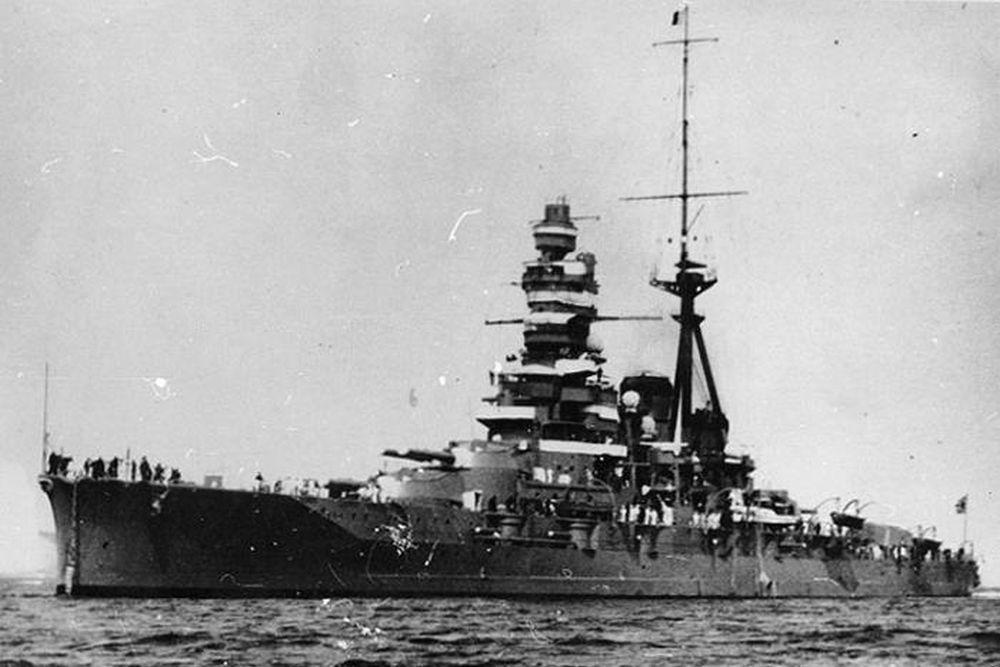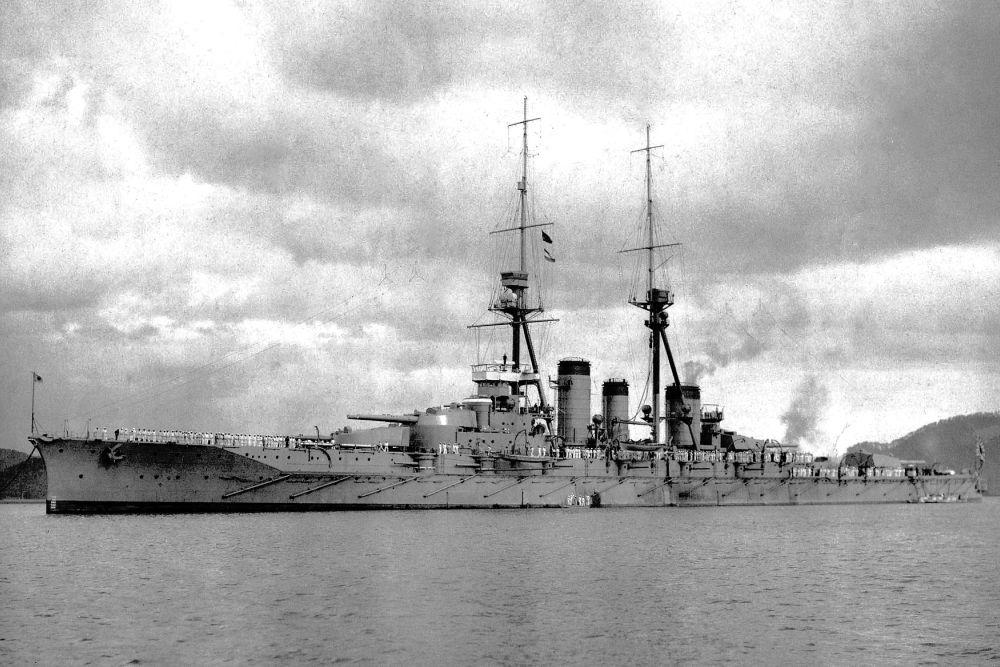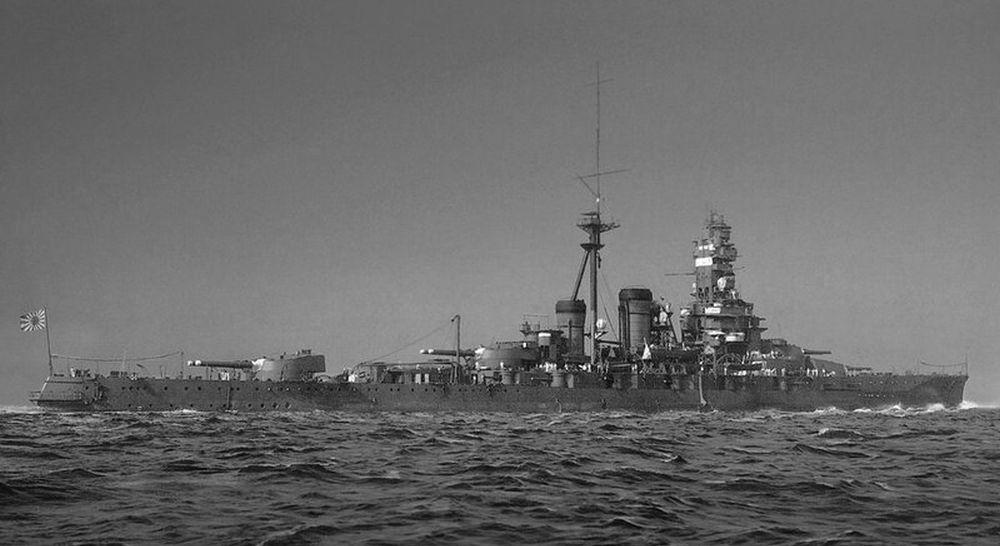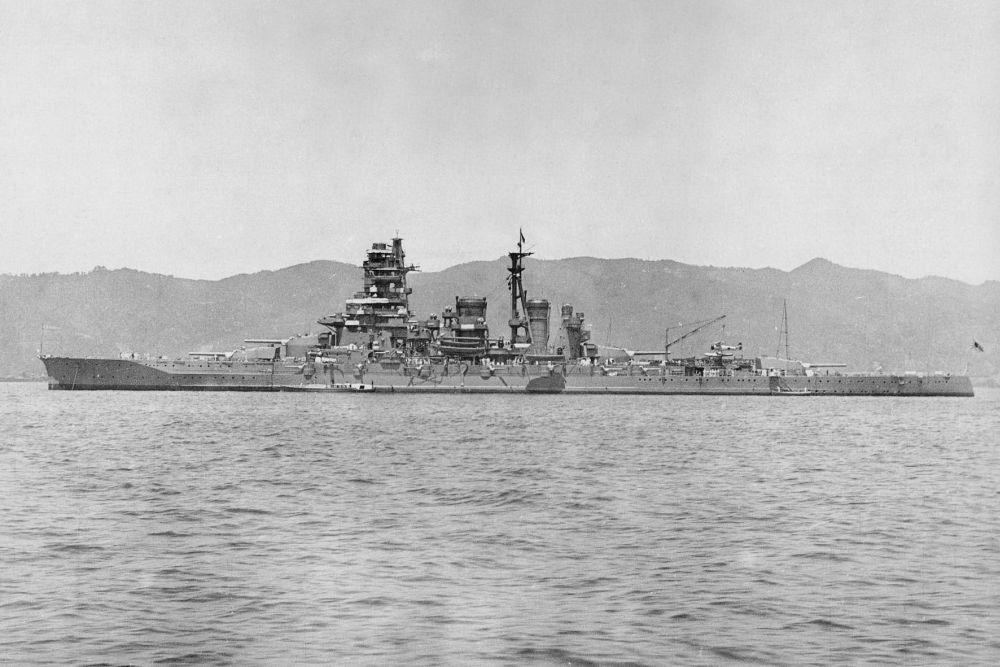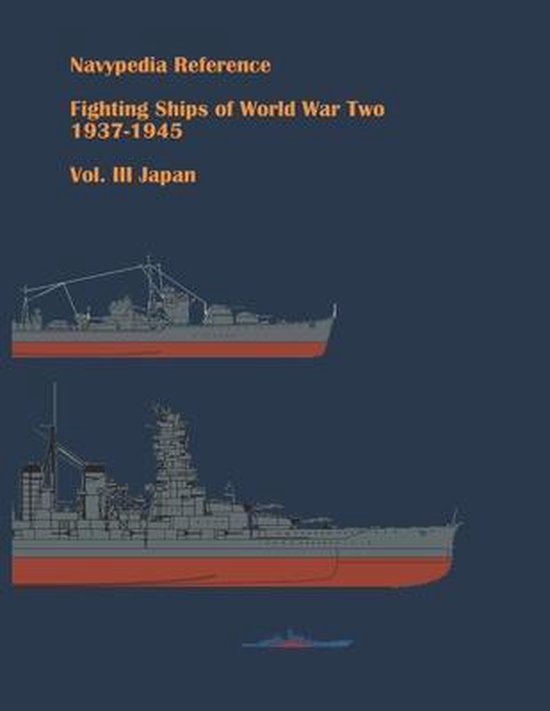Introduction
The Japanese battlecruiser Kirishima was built at the Mitsubishi shipyard in Nagasaki between 1912 and 1915. During two consecutive periods, 1927-1930 and 1934-1936, the ship was significantly reconstructed and modernised, resulting into the classification as a battleship. During the Second World War, she participated with the 3rd Battleship Division in the attack on Pearl Harbor, the Dutch East Indies campaign, the Battle of Midway, the Battle of the Eastern Solomon Islands, the Battle of Santa Cruz and the Battle of Guadalcanal. During the Second Battle of Guadalcanal, the Kirishima was sunk by the American battleship USS Washington (BB-56) on November 15th, 1942.
Definitielijst
- battleship
- Heavily armoured warship with very heavy artillery.
- Midway
- Island in the Pacific where from 4 to 6 June 1942 a battle was fought between Japan and the United States. The battle of Midway was a turning point in the war in the Pacific resulting in a heavy defeat for the Japanese.
- Nagasaki
- Japanese city on which the United States dropped the second atomic bomb on 9 August 1945.
General Information
| Built by: |
Keel laid: |
Launched: |
Commissioned: |
Fate: |
| Mitsubishi Goshi
Kaisha Nagasaki |
March 17th, 1912 |
December 1st, 1913 |
April 19th, 1915 |
November 15th, 1942 (sunk) |
| Construction Nr. : 85 |
||||
| Stationing: |
Date in: |
Date out: |
||
| April 19th, 1915 |
1st Battleship Division |
|||
| November 1915 |
3rd Battleship Division |
|||
| December 1926 |
3rd Reserve Fleet |
|||
| November 1938 |
3rd battleship Division |
|||
Definitielijst
- Battleship
- Heavily armoured warship with very heavy artillery.
- Nagasaki
- Japanese city on which the United States dropped the second atomic bomb on 9 August 1945.
History
The keel for the Japanese battlecruiser Kirishima was laid on March 17th, 1912, at the Mitsubishi shipyard in Nagasaki. She was launched on December 1st, 1913, and commissioned on April 19th, 1915. The battlecruiser was named after Mount Kirishima on Kyushu and the third ship of the Kongo-class (1912). The ship was built entirely in Japan with parts that were also manufactured in Japan, but her design was based on that of the British battleship HMS Erin (1913).[1][2][3]
With a displacement of 31,980 tons and a length of just over 222 meters, the Kirishima was powered by four gas turbines and eight boilers generating136,000 hp to achieve a maximum speed of 30.5 knots (55.56 km/h). The 6,330 tons of fuel provided the ship a range of 18,520 km at a cruising speed of 18 knots (33.34 km/h). The 1,437 crew members availed of a main armament of 4x2 356mm/45 calibre Type 41 guns and a secondary armament of 14x1 152mm/50 calibre Type 41 guns, 4x2 127mm/40 calibre Type 89 guns and 10 x 2 25mm/60 calibre Type 96 anti-aircraft guns.[4][5][6]
On April 19th, 1915, the Kirishima entered service with the 1st Battleship Division within the Dai-ichi Kantai (1st Fleet). After seven months of sea trials, the ship was transferred to the 3rd Battleship Division within the Dai-ni Kantai (2nd Fleet). Together with the Haruna (1915), the Kirishima left Sasebo for the East China Sea in April 1916. After ten days the ships returned, and the Kirishima remained in Sasebo until April 1917. This was followed by another deployment along the Chinese coast, this time with the Haruna and the Kongo (1913). In April 1918, a final deployment during the First World War followed alongside the Chinese and Korean coasts.
After the First World War, several battleships were placed in reserve, including the Kirishima. On December 1st, 1920, another re-assignment to the 3rd Battleship Division followed. Kirishima mainly remained in and around Sasebo. In September 1923, the ship assisted in relief efforts after the Great Kanto earthquake until the ship was again placed in reserve in December 1923.
Due to the international naval treaties, Japan was no longer allowed to build new large warships. The Japanese Navy decided to modernise the older battlecruisers into battleships within the restrictions of the treaties. The reconstruction of the Kirishima began in early 1927. In particular her armour was upgraded and expanded, and bulges were constructed alongside the hull to protect the ship against torpedo impacts. The outdated propulsion was modernised by replacing the coal-fired Yarrow boilers with ten more powerful Kampon boilers. The forward superstructure was reconstructed, and the forward mast was rebuilt in the typical Japanese pagoda style. The new propulsion and rebuilding of the superstructure made it possible to remove one of the three funnels. The ship was completed on April 16th, 1930.[7][8]
Between August and October 1930, the Kirishima had dedicated equipment installed to accommodate float planes. In April 1932 the ship was deployed along the Chinese coast near Shanghai and returned to reserve shortly afterwards. When Japan met with international condemnation for its interference in Manchuria in the early 1930s, the country withdrew from all fleet treaties that removed all restrictions on ships. This paved the way for a significant construction and renovation program. The Kirishima was modernised in the mid-1930s. On November 18th, 1934, the ship went into dry dock at Sasebo. Her stern was extended by 7.9 meters, and the entire superstructure was completely rebuilt. The propulsion was upgraded by installing eight new Kampon boilers and new geared turbines. Both the main guns and secondary guns got a better field of fire. The Kirishima received new Nakajima E8N and Kawanishi E7K aircraft, for which new catapults were also installed. The old 76.2 mm guns were replaced by eight 127 mm guns and twenty 25 mm anti-aircraft guns were placed in double-barrel formations. Two of her 152 mm guns and the remaining torpedo tubes were also removed. The armour was extensively upgraded. The ship returned into service on June 8th, 1936. Thanks to the new propulsion, this battleship could now reach 30.5 knots (56.5 km/h).[9][10][11][12][13][14][15]
After the reconstruction, the Kirishima was deployed to patrol along the Chinese coast from August 1936. After the outbreak of the 2nd Sino-Japanese War, the ship regularly participated in transport operations carrying troops and supplies. The ship was designated the flagship of the 3rd Battleship Division from November 1938 onwards. In November 1939, the Kirishima was again placed in reserve and her armament was outfitted with additional protective armour.
During November 1941, the Kirishima was fully equipped for deployment in war zones. Together with the other ships of the 3rd Battleship Division, she departed on November 26th from the assembly point in Hitokappu Bay to join the aircraft carrier fleet for the attack on Pearl Harbor on December 7th, 1941. After the attack, the Kirishima returned to Japan.[16]
The Kirishima left the naval base at Truk on January 8th, 1942, and together with aircraft carriers participated in the invasion of New Britain on January 17th. In March 1942, the Kirishima was involved in the sinking of the American destroyer USS Edsall (DD-219). As of April 1942, the Kirishima operated with the Japanese fleet in the Indian Ocean, after which the ship returned to be dry-docked for maintenance. During this time, additional anti-aircraft defence was installed as well as a new radar.[17][18]
In June 1942, the Kirishima was involved in the Battle of Midway and picked up survivors from the sunk Japanese aircraft carriers. After the battle, the ship returned to Japan and left for the Solomon Islands with her division in August 1942. After the battle of the Eastern Solomon Islands, the Kirishima returned to Truk and was subsequently involved in the battle of Santa Cruz. On October 26th, the Kirishima was attacked by American dive bombers but did not suffer damage.[19]
During the night battle of Savo, November 12th to 13th, 1942, the Kirishima was damaged by 203mm naval artillery from one of the American adversaries but was able to continue the battle. During the Second Battle of Guadalcanal on the night of November 14th-15th, 1942, the Kirishima was hit at least 49 times by guns from the USS Washington (BB-56) and the USS South Dakota (BB-57) and sank during the morning.[20]
Definitielijst
- battleship
- Heavily armoured warship with very heavy artillery.
- destroyer
- Very light, fast and agile warship, intended to destroy large enemy ships by surprise attack and eliminating them by using torpedoes.
- First World War
- Took place from 1914 till 1918 and is also named The Great War. The conflict started because of increased nationalism, militarism and neo-colonialism in Europe. Two alliances battled one another during the 4-year war, which after a dynamic start, resulted into static trench warfare. The belligerents were the Triple Alliance (consisting of Great-Britain, France, and Russia; later enlarged by Italy and the USA, amongst others) on the one hand and the Central Powers (consisting of Germany, Austria-Hungary, Bulgaria and the Ottoman empire) on the other hand. The war was characterized by the huge number of casualties and the use of many new weapons (flamethrowers, aircraft, poison gas, tanks). The war ended in 1918 when Germany and its allies surrendered unconditionally.
- invasion
- Armed incursion.
- mid
- Military intelligence service.
- Midway
- Island in the Pacific where from 4 to 6 June 1942 a battle was fought between Japan and the United States. The battle of Midway was a turning point in the war in the Pacific resulting in a heavy defeat for the Japanese.
- Nagasaki
- Japanese city on which the United States dropped the second atomic bomb on 9 August 1945.
- radar
- English abbreviation meaning: Radio Detection And Ranging. System to detect the presence, distance, speed and direction of an object, such as ships and airplanes, using electromagnetic waves.
- torpedo
- A weapon of war. A cigar shaped body fitted with explosives and a propulsion and control mechanism. Intended to target after launch a nearby enemy ship and disable it by underwater explosion.
Technical Specifications
| Name: | Kirishima |
| Callsign/Registration: |
? |
| Shipyard: |
Mitsubishi Goshi Kaisha, Nagasaki |
| Hullnumber: |
85 |
| Type/Class: |
Battlecruiser - Battleship /
Kongo-class (1912) |
| Displacement: |
36,600 long tons (37,187 tons) |
| Length: |
222 meter |
| Beam: |
31 meter |
| Draft: |
9,70 meter |
| Propulsion: |
4 schachten 136.000 pk (101.415 kW) |
| Speed: |
30 knots (56 km/h) |
| Range: |
19.000 km at 14 knots (26
km/h) |
| Armor: |
Deck: 38 - 58 mm Turrets: 230 mm Barbettes: 250 mm Armor Belt: 200–280 mm |
| Waepons: |
4x2 356 mm guns 16x1 152 mm guns 8x1 127 mm / 50 calibre guns 8x 530 mm torpedotubes |
| Complement: |
1.360 |
Definitielijst
- Battleship
- Heavily armoured warship with very heavy artillery.
- Nagasaki
- Japanese city on which the United States dropped the second atomic bomb on 9 August 1945.
Commanders
| Kaigun Daisa Rokuro Kamaya
(Captain of the Navy) |
December 15th, 1914 |
| Kaigun Daisa Takeshi Shima
(Captain of the Navy) |
December 13th, 1915 |
| Kaigun Daisa Junichi Matsumura
(Captain of the Navy) |
December 1st, 1916 |
| Kaigun Daisa Masaki Nakamura (Captain of the Navy) | July 16th, 1917 |
| Kaigun Daisa Kinzaburo Mimura (Captain of the Navy) | December 1st, 1917 |
| Kaigun Daisa Genjiro Katsuki
(Captain of the Navy) |
November 10th, 1918 |
| Kaigun Daisa Hisashi Yokoo
(Captain of the Navy) |
November 20th, 1919 |
| Kaigun Daisa Sukeichi Yasumura
(Captain of the Navy) |
January 8th, 1920 |
| Kaigun Daisa Heigo Teraoka
(Captain of the Navy) |
December 1st, 1921 |
| Kaigun Daisa Masataka Ando
(Captain of the Navy) |
December 1st, 1922 |
| Kaigun Daisa Teiji Sakamoto
(Captain of the Navy) |
November 6th, 1923 |
| Kaigun Daisa Hisanori Fujita
(Captain of the Navy) |
December 1st, 1924 |
| Kaigun Daisa Takayoshi Kato
(Captain of the Navy) |
October 20th, 1925 |
| Kaigun Daisa Naojiro Honshuku
(Captain of the Navy) |
December 1st, 1926 |
| Kaigun Daisa Kanekoto Iwamura
(Captain of the Navy) |
December 1st, 1927 |
| Kaigun Daisa Yoshikazu Furukawa (Captain of the Navy) | March 10th, 1928 |
| Kaigun Daisa Choji Inoue
(Captain of the Navy) |
December 10th, 1928 |
| Kaigun Daisa Minoru Hirota
(Captain of the Navy) |
February 8th, 1929 |
| Kaigun Daisa Takuo Fujisawa
(Captain of the Navy) |
November 1st, 1929 |
| Kaigun Daisa Shigeru Kikuno
(Captain of the Navy) |
December 1st, 1930 |
| Kaigun Daisa Sekizo Uno
(Captain of the Navy) |
December 1st, 1931 |
| Kaigun Daisa Haruo Kitaoka
(Captain of the Navy) |
December 1st, 1932 |
| Kaigun Daisa Ibo
Takahashi (Captain of the Navy) |
November 15th, 1933 |
| Kaigun Daisa Kunji Tange
(Captain of the Navy) |
November 15th, 1934 |
| Kaigun Daisa
Gunichi Mikawa (Captain of the Navy) |
November 15th, 1935 |
| Kaigun Daisa Kakusaburo Makita
(Captain of the Navy) |
December 1st, 1936 |
| Kaigun Daisa Masao Kanazawa
(Captain of the Navy) |
December 1st, 1937 |
| Kaigun Daisa Takeo Tada
(Captain of the Navy) |
November 15th, 1938 |
| Kaigun Daisa Saichiro Tomonari
(Captain of the Navy) |
December 17th, 1939 |
| Kaigun Daisa Kazutaka Shiraishi
(Captain of the Navy) |
October 19th, 1940 |
| Kaigun Daisa Jihei Yamaguchi
(Captain of the Navy) |
August 15th, 1941 |
| Kaigun Daisa Sanji
Iwabuchi (Captain of the Navy) |
April 20th, 1942 |
Notes
- Gogin, 2021, pag. 18
- Gray, 1984, pag. 234
- Gray, 1984, pag. 234
- Gogin, 2021, pag. 18
- Jackson, 2008, pag. 27
- Stille, 2008, pag. 17
- Wilmott, 2004, pag. 45
- Whitley, 1998, pag. 178-180
- Jackson, 2000, pag. 72
- Gogin, 2021, pag. 18-19
- Wilmott, 2004, pag. 35
- Jackson, 2008, pag. 27
- Stille, 2008, pag. 17
- McCurtie, pag. 185
- Wilmott, 2004, pag. 35
- Wilmott, 2004, pag. 50-51
- Gogin, 2021, pag. 19
- Jackson, 2000, pag. 119-120
- Stille, 2008, pag. 19
- Gogin, 2021, pag. 19
Information
- Article by:
- Wilco Vermeer
- Translated by:
- Simon van der Meulen
- Published on:
- 17-02-2025
- Feedback?
- Send it!
Related books
Sources
- BISHOP, C, The Encyclopedia of Weapons of WWII, Barnes & Noble, Inc., New York, 1998.
- GOGIN, I. & DASHYAN, A., Fighting Ships of World War Two volume 3, Navypedia LLC, Gatchina, 2021.
- GRAY, R., Conway's All The World's Fighting Ships, 1906-1921, Bloomsbury Publishing Plc., 1984.
- JACKSON, R., 101 Great Warships, Amber Books, 2008.
- JACKSON, R., The World's Great Battleships, Greenwich Editions, Londen, 2000.
- MCCURTIE, F.E. e.a., Jane's fighting ships of World War II.
- STILLE, M., Imperial Japanese Navy Battleships 1941-45, Bloomsbury USA, 2008.
- WHITLEY, M.J., Battleships of World War Two, Naval Institute Press, 1998.
- WILLMOTT, H.P., The Second World War in the Far East, Smithsonian Books, 2004.
